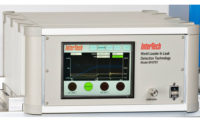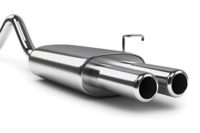Leak testing and leak detection is a broad field and includes various methods for detecting environmentally damaging or hazardous leaks in process industries and distribution networks, water leakage in buildings and swimming pools, and methods used in manufacturing to ensure product performance and safety. For this introduction to leak testing methods and a look at advances in technology, we’ll limit our discussion to the latter.
Non-quantifiable vs. quantifiable leak testing methods
Leak testing methods can be broadly categorized as subjective and non-quantifiable or non-subjective and quantifiable. Immersing the test piece in water and looking for bubbles is a simple method of leak testing. It is totally subjective and at best, the quantifiable result obtained by collecting bubbles is unreliable.
Some modern methods may not be as subjective but may still be unquantifiable. Trace gas sniffing where the test piece is filled with a trace gas such as helium can detect parts per million egress but not necessarily a quantified leak rate. However, it will tell the operator where the leak is located, something that the other common techniques cannot.
In today’s data driven manufacturing environment we want hard data on leak rates, reject percentages, gage range and repeatability and other data. Therefore, we are overwhelmingly concerned with non-subjective and quantifiable leak testing.
Data driven modern leak testing methods
Pressure decay leak testing, wherein the test piece is pressurized to a known test pressure, isolated and allowed to stabilize and then monitored for a drop in pressure. As long as we know the test pressure, part volume and test time, we can calculate the leak rate from the pressure drop. The calculations can be done manually, using a spreadsheet macro, or they can be performed by the leak tester firmware or software. Using a calibrated leak master, the leak tester can be “taught” to recognize what a leak looks like regardless of the volume.
Differential pressure testing uses a special differential transducer capable of detecting very small changes in pressure from one side of a thin flexible diaphragm to the other. This method depends on the use of a reference volume and can provide volumetric leak rates very quickly and accurately and is many times more sensitive than simple pressure decay testing.
For example, if you were monitoring an analog gage to detect decay at 60 psi you might be able to see a change of one psi watching the gage. If you have a differential analog gage with a full-scale range of three psi, you could easily see a change in pressure of just 0.1 psi. That’s because the differential gage is only measuring the difference in pressure between the two ports, it’s not measuring the actual gage pressure in the test part.
Mass flow testing is a technique that has gained recent popularity. This involves creating a prescribed pressure within the product being tested and then using a flow measurement transducer to measure the airflow that is needed to maintain that pressure. The leak tester resolves a true volumetric leak rate.
Trace gas detection methods reach their pinnacle with the technique of mass spectrometry. The test piece is bombarded with helium or for greater sensitivity, the part is filled with helium while it is located in a vacuum chamber. A sensitive mass spectrometer detector is used to monitor leaks. The vacuum method, sometimes known as hard vacuum mass spectrometry, is extremely sensitive, and can resolve leak rates by calibrating the instrument with a known master leak. It is however the most expensive of the common test methods.
So which method is best? There is really no “best” method. The most suitable method strikes the right balance between the test objectives, the test budget, the production throughput required, and the desired reject criteria. Given identical test parts, different engineers may choose different techniques depending upon any or all of the aforementioned.
Advances in design of leak testers
Today’s leak testers can do so much more than leak testing. High powered processors enable instrument designers to add additional data channels to create multi channel testers that can accept multiple transducers or sensors, not only those that measure pressure or flow, but temperature or force measurement can be included. This can turn a leak tester into a multipurpose machine, adding value and saving space.
Increased data storage capacity is enabling users to capture and analyze data beyond simple pass or fail results. Today’s testers can grade parts, perform statistical analysis, display data as histograms and update in real time as the user observes. This empowers manufacturing professionals to make smarter and faster decisions based upon the data supplied by the leak tester.
Increased memory capacity has enabled an increase in the number of programs the leak tester can store. This in turn enables the user to create sequences of tests by linking programs depending upon events. It’s also useful to have more programs, making it quick to change from one set of test parameters to another.
Advances in electronic components have given leak testers improved performance, and have helped manufacturers of leak testers deliver user-friendly features such as touch screen HMI panels, circuit visualization, the ability to merge leak test data with machine data, and greater input/output controls. Coupled with the improved performance of the instrumentation, today’s leak test systems can deliver faster throughput, greater repeatability, and a choice of communication protocols that can take the data from the test station and store it on remote servers where it can be combined with other data collected up or downstream.
Another interesting development is the use of RFID tags. Commonly stored data on an RFID tag might be part number, serial number, lot number, date of manufacture, plant and/or line identification and almost anything else you can think of. With the latest leak testers, it’s possible to connect a RFID reader and writer to the instrument with a null modem cable. The tester can read the data and bring that into the leak tester where it can be combined with the leak test result and written back to the RFID tag as well as stored on the leak tester and subsequently exported to a computer or portable media.
RFID tags customized in this way are particularly helpful if you manufacture disposable parts that work together with a module or a console. In such applications, when the parts are connected to the console, the RFID tag communicates the specific part that is connected to it and provides information about the physical parameters needed for the test solution to proceed.
A newer subset of RFID tagging is the use of Near Field Communications Tags (NFC). These store a limited amount of information but NFC sensors could be used for simple applications like telling the leak tester what the temperature of the test piece is so that the correct temperature compensation can be applied.
What challenges lie ahead in the field of leak testing? The advances in nanotechnology and Micro-Electro-Mechanical-Systems (MEMS) are sure to throw up more challenges with very tight test specifications and difficult to handle products for which a step change in technology may be required. Watch this space for more.





